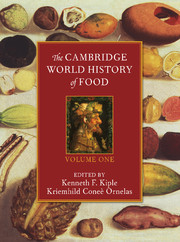Book contents
- Frontmatter
- Introduction
- Part I Determining What Our Ancestors Ate
- Part II Staple Foods: Domesticated Plants and Animals
- II.A Grains
- II.A.1 Amaranth
- II.A.2 Barley
- II.A.3 Buckwheat
- II.A.4 Maize
- II.A.5 Millets
- II.A.6 Oat
- II.A.7 Rice
- II.A.8 Rye
- II.A.9 Sorghum
- II.A.10 Wheat
- II.B Roots, Tubers, and Other Starchy Staples
- II.C Important Vegetable Supplements
- II.D Staple Nuts
- II.E Animal, Marine, and Vegetable Oils
- II.F Trading in Tastes
- II.G Important Foods from Animal Sources
- Part III Dietary Liquids
- Part IV The Nutrients – Deficiencies, Surfeits, and Food-Related Disorders
- References
II.A.10 - Wheat
from II.A - Grains
Published online by Cambridge University Press: 28 March 2008
- Frontmatter
- Introduction
- Part I Determining What Our Ancestors Ate
- Part II Staple Foods: Domesticated Plants and Animals
- II.A Grains
- II.A.1 Amaranth
- II.A.2 Barley
- II.A.3 Buckwheat
- II.A.4 Maize
- II.A.5 Millets
- II.A.6 Oat
- II.A.7 Rice
- II.A.8 Rye
- II.A.9 Sorghum
- II.A.10 Wheat
- II.B Roots, Tubers, and Other Starchy Staples
- II.C Important Vegetable Supplements
- II.D Staple Nuts
- II.E Animal, Marine, and Vegetable Oils
- II.F Trading in Tastes
- II.G Important Foods from Animal Sources
- Part III Dietary Liquids
- Part IV The Nutrients – Deficiencies, Surfeits, and Food-Related Disorders
- References
Summary
Wheat, a grass that today feeds 35 percent of the earth’s population, appeared as a crop among the world’s first farmers 10,000 years ago. It increased in importance from its initial role as a major food for Mediterranean peoples in the Old World to become the world’s largest cereal crop, feeding more than a billion people in the late twentieth century (Feldman 1976: 121). It spread from the Near East, where it first emerged in the nitrogen-poor soils of a semiarid Mediterranean climate, to flourish in a wide range of environments – from the short summers of far northern latitudes, to cool uplands, to irrigated regions of the tropics. The real story of its origins disappeared from memory many millennia in the past, although some farming peoples still recount tales of how they received other cultivated plants from gods, animate spirits, heroic ancestors, or the earth itself. But today we must use botanical and archaeological evidence to trace the story of wheat’s domestication (implying a change in a plant’s reproduction, making it dependent on humans) and its spread.
Domesticated wheats belong to at least three separate species (Zohary 1971: 238) and hundreds of distinct varieties, a number that continues to increase because the domestication of wheat continues. All domesticated wheat has lost the physical and genetic characteristics that would allow it aggressively to reseed and sprout by itself – losses which clearly distinguish domesticated wheats from wild relatives. Furthermore, both the remarkable geographic distribution of domesticated wheat and the species' very survival depend on human beings. If no one collected wheat seeds and planted them in cleared, fertile ground, waving fields of grain soon would support hundreds of weeds, to be replaced by wild plants, and perhaps eventually by saplings and forests. Domesticated wheat and humans help each other in a relationship known as “mutualism” (Rindos 1984: 255).
- Type
- Chapter
- Information
- The Cambridge World History of Food , pp. 158 - 174Publisher: Cambridge University PressPrint publication year: 2000
References
- 6
- Cited by

